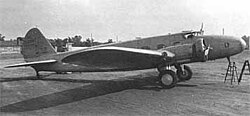United Air Lines Flight 23
 A Boeing 247 similar to the aircraft involved | |
| Incident | |
|---|---|
| Date | October 10, 1933 |
| Summary | Deliberate on-board explosion |
| Site | Near Chesterton, Indiana, US 41°34′12″N 86°59′18″W / 41.57000°N 86.98833°W |
| Aircraft | |
| Aircraft type | Boeing 247D |
| Operator | United Air Lines |
| Registration | NC13304 |
| Flight origin | Newark, New Jersey, US |
| 1st stopover | Cleveland, Ohio, US |
| Last stopover | Chicago, Illinois, US |
| Destination | Oakland, California, US |
| Passengers | 4 |
| Crew | 3 |
| Fatalities | 7 |
| Survivors | 0 |
United Air Lines Flight 23 was a regularly-scheduled flight operated by United Air Lines[a] between Newark, New Jersey, and Oakland, California, with intermediate stops. On October 10, 1933, the Boeing 247 airliner serving the flight, registered as NC13304[1], exploded and crashed near Chesterton, Indiana, United States, en route from Cleveland to Chicago. It carried three crew and four passengers. All aboard died in the crash, which was caused by an on-board explosive device. Eyewitnesses on the ground reported hearing an explosion shortly after 9 pm and seeing the aircraft in flames at an altitude around 1,000 feet (300 m). A second explosion followed after the aircraft crashed. The crash scene was adjacent to a gravel road about 5 miles (8 km) outside of Chesterton, centered in a wooded area on the Jackson Township farm of James Smiley.[2][3]
Investigators combed through the debris and were confronted with unusual evidence; the toilet and baggage compartment had been smashed into fragments. Shards of metal riddled the inside of the toilet door, while the other side of the door was free of the metal fragments. The tail section had been severed just aft of the toilet and was found mostly intact, with two of the victims' bodies nearby,[3] almost a mile away from the main wreckage.[4]
The Federal Bureau of Investigation declassified 324 documents related to the investigation on November 16, 2017.[3][non-primary source needed] It is notable for being the first proven act of air sabotage in the history of commercial aviation.[citation needed]
Incident
[edit]United States Bureau of Investigation investigator Melvin Purvis said, "Our investigation convinced me that the tragedy resulted from an explosion somewhere in the region of the baggage compartment in the rear of the aircraft. Everything in front of the compartment was blown forward, everything behind blown backward, and things at the side outward." He also noted that the gasoline tanks "were crushed in, showing [that] there was no explosion in them."[5]
Investigation
[edit]Dr. Carl Davis of the Porter County coroner's office[6] and experts from the Crime Detection Laboratory at Northwestern University[4][7] examined evidence from the crash and concluded that it was caused by a bomb, with nitroglycerin as the probable explosive. One of the passengers was seen carrying a brown package onto the aircraft in Newark, but investigators found the package amidst the wreckage and ruled it out as the source of the explosion.[4] Investigators found a rifle in the wreckage, but they determined that a passenger carried it aboard as luggage, as he was en route to a shoot at Chicago's North Shore Gun Club.[4][6] No suspect was ever identified in this incident and it remains unsolved.[8]
Pilot Captain Terrant, co-pilot A.T. Ruby, stewardess Alice Scribner, and all four passengers were killed. Scribner was the first United stewardess to be killed in an aircraft crash.[8]
See also
[edit]- 1933 in aviation
- List of accidents and incidents involving commercial aircraft
- List of firsts in aviation
Notes
[edit]- ^ In 1933, United Airlines was known as United Air Lines. The company name was changed in 1974.
References
[edit]- ^ "FAA Registry (NC13304)". Federal Aviation Administration.
- ^ "Seven Killed in Crash of Giant Transport Plane" (PDF). The Citizen-Advertiser. Auburn, NY. AP. 11 October 1933. p. 12.
- ^ a b c "1933 Crash of United Airlines Trip 23 Boeing 247 NC13304 Part 01 of 01". Federal Bureau of Investigation. Retrieved October 23, 2021.
- ^ a b c d "Aeronautics: Death on No. 23". TIME. 23 October 1933. Archived from the original on February 4, 2013.
- ^ "Plane wreck laid to nitroglycerine". The New York Times. October 15, 1933. p. 31. Retrieved 2024-10-11.
- ^ a b "Suspects Bomb Wrecked Plane" (PDF). Prescott Evening Courier. AP. 12 October 1933. p. 3.[permanent dead link]
- ^ "Wreck of air liner laid to a bomb". The New York Times. 14 October 1933. p. 5. Retrieved 2024-10-11.
- ^ a b van der Linden, F. Robert (November 1991). The Boeing 247: The First Modern Airliner (Google Books preview). Seattle, WA: University of Washington Press. p. 83. ISBN 0-295-97094-4.
External links
[edit]- "Seven die as plane crashes in flames". The New York Times (October 11, 1933), p. 1 (pay site)
- "Plane crash laid to blast in air". The New York Times (October 12, 1933), p. 3 (pay site)
- "Seek 'bomber' of plane". The New York Times (October 16, 1933), p. 7 (pay site)
- "Jackson Center, IN Airplane Crash, Oct 1933". gendisasters.com. Archived from the original on March 11, 2012. – includes names and addresses of the deceased
- 1933 in Indiana
- 1933 murders in the United States
- Accidents and incidents involving the Boeing 247
- Airliner accidents and incidents in Indiana
- Airliner bombings in the United States
- Aviation accidents and incidents in the United States in 1933
- Crimes in Indiana
- Explosions in 1933
- Explosions in Indiana
- Mass murder in 1933
- Mass murder in Indiana
- Mass murder in the United States in the 1930s
- October 1933 events
- Porter County, Indiana
- United Airlines accidents and incidents
- Unsolved airliner bombings
- Unsolved mass murders in the United States
